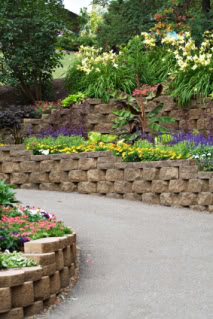Keystone Retaining Walls

A retaining wall can be used to straighten out sloped areas, control erosion, provide structural support to fences, create terraced land, and enhance the overall appearance of your yard. The wall can “tame” a wild-looking property, or add distinct style to a bare home. Though building a retaining wall can cost quite a bit of money, it can add significant value to your home and expand your living space. Retaining walls can be made of brick, wood, or a host of other materials, but concrete blocks are the most durable, and Keystone is the industry leader.
Can I Build a Retaining Wall on My Own?
Depending on the size and complexity of your property and desired wall, a retaining wall can be built either by a contractor or on your own. However, if you lack the proper tools, have a complicated landscape, or are planning on building a wall taller than three feet, you should contact a local concrete contractor. Heavier, more complex walls require reinforced materials and an engineer should be consulted.
Keystone walls are made of non-corrosive, low-absorption concrete, and come in segmental blocks. The blocks are interlocked and held together with fiberglass pins, thus eliminating the need for mortar, enabling easy, efficient construction. The result is a durable, cost-efficient, long-lasting wall, that’s environmentally friendly as well as weather resistant.
How Much Will It Cost?
The Keystone blocks cost anywhere from $5 - $20 a square foot, depending on the block’s style and texture. Installation fees can add about $5 - $10 per square foot. There are a wide range of shapes, sizes, textures and colors to choose from, so design options are almost endless.
Important Things to Keep in Mind
Regardless of the material and style you choose, your retaining wall must have a strong base, a good backfill, and proper drainage capabilities. The foundation must be solid, otherwise the wall can be swept away or sink if moisture softens the earth beneath it. Because water is heavy, any region that receives a substantial amount of rainfall, like Philadelphia, Pennsylvania, for example, should have a gravel backfill, or a similar material that drains quickly. Your wall will act as a dam for all running water, whether above or below ground. For the wall to remain sturdy, the water must be able to pass through easily.
Additional Costs
Once you’ve added this charming, functional structure, you may want to hire an electrician to install outdoor lighting to accent the structure in the evening, and/or illuminate low-level walls to keep people from stumbling in the dark.
If you decide to build the wall yourself but want a professional design engineer to help with the plans, this can add a few hundred dollars to the cost.
Be sure to check with your local planning department and ensure you are permitted to build a wall, and see if there are height or other structural limitations.
Mark Stevens is a writer from New Jersey who has written over 100 home improvement articles. Want to ask Mark something? Send him a message.
Looking for a Pro? Call us (866) 441-6648

Concrete Average Costs
Concrete Contractors Experiences

Hiring A Great Landscaper Was Almost Too Easy, Even Long Distance

Contracted A Large Tree Trimming Job For A Reasonable Price



